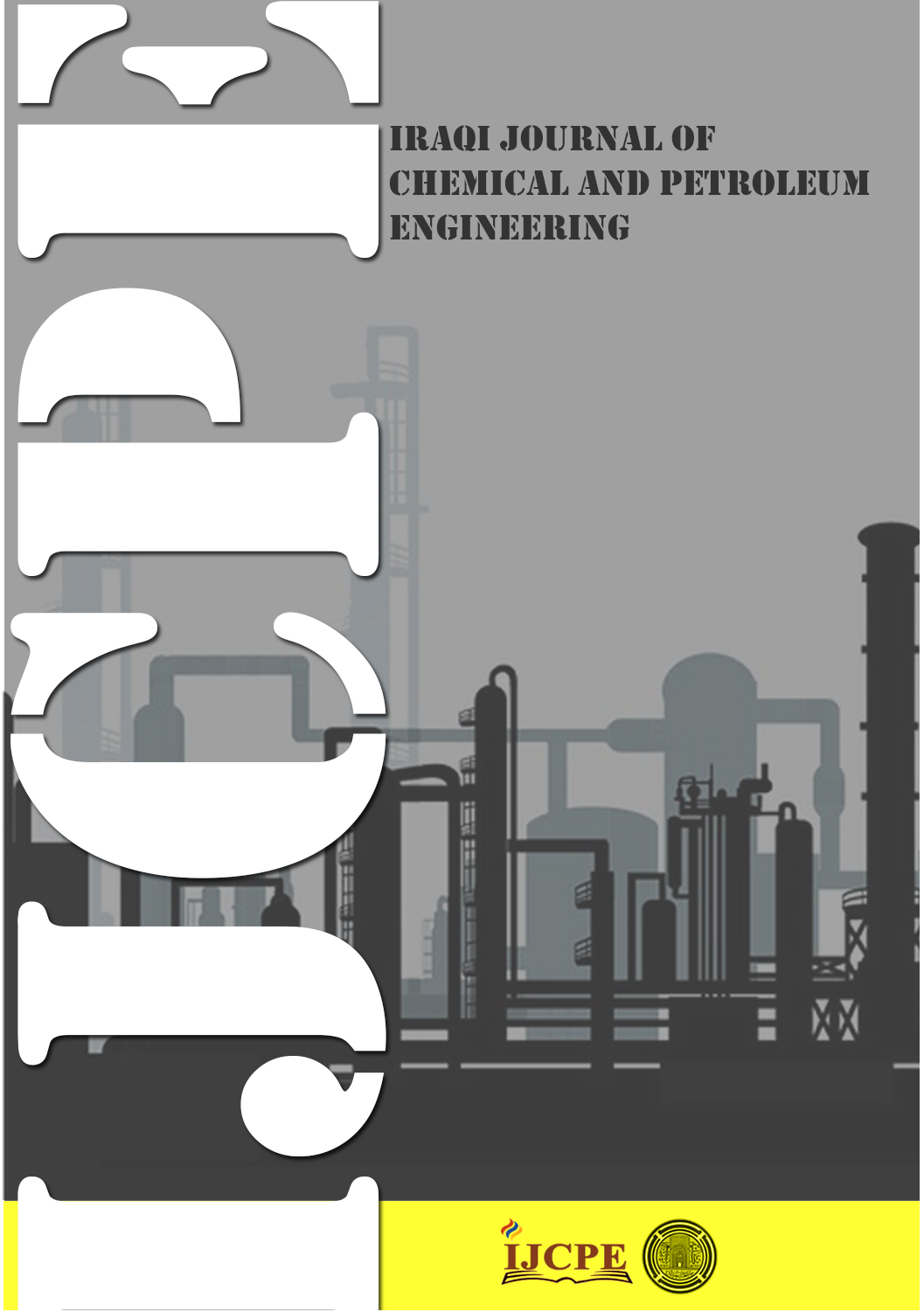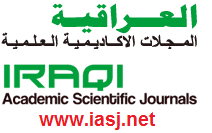Comparative study for degradation of Congo red dye from synthetic wastewater by photocatalytic redox reactions using various nanoscale semiconductors
DOI:
https://doi.org/10.31699/IJCPE.2025.2.9Keywords:
Photocatalyst; Advanced oxidation process; Energy consumption; Kinetic study; Reactor design; Recycle ratioAbstract
A comparative study for two nanoscale semiconductors (TiO2 and WO3) was conducted as heterogeneous photocatalysts to degrade about 50 ppm of Congo red dye in an aqueous solution. The reaction was carried out in a batch reactor placed in a dark box and equipped with an air pump. The dye solution and 0.2 g/L of the catalyst were mixed, firstly, in a dark environment to monitor the amount of adsorbed dye, then the ultraviolet light was turned on with two different powers (15 and 30 W) to study the photocatalytic degradation reactions. The results showed that TiO2 had higher photocatalytic activity to degrade the dye. The CRD removal values for TiO2 and WO3 were 99.67 and 72.16 %, respectively, using 15 W, and the UV power did not have a significant effect on redox reactions according to the observations and the electrical energy consumption. The reaction kinetics study showed that the results obtained followed a first-order kinetics model. A mathematical model was developed based on the recycle ratio approach to study the effects of the recycle ratio and space-time on the Congo red dye removal through the different types of reactors. The simulated results showed that the ideal plug flow reactor performance gave the highest removal in less space-time than the recycle plug flow reactors. The recorded reactor performance decreased with the increasing recycling ratio, and the worst reactor performance was reported for the mixed-flow reactor.
Received on 10/10/2024
Received in Revised Form on 06/12/2024
Accepted on 06/12/2024
Published on 30/06/2025
References
[1] M. J. Muñoz-Batista and R. Luque, "Heterogeneous Photocatalysis," Chemical Engineering, vol. 5, no. 2, p. 26, May 2021. https://doi.org/10.3390/chemengineering5020026
[2] C. Chee, A. Abd, S. Ibrahim, M. Matheswaran, and P. Saravanan, "Heterogeneous Photocatalytic Oxidation as an Effective Tool for Wastewater Treatment – A Review," in Studies on Water Management Issues, InTech, 2012. https://doi.org/10.5772/30134
[3] M. A. Oturan and J. Aaron, "Advanced Oxidation Processes in Water/Wastewater Treatment: Principles and Applications. A Review," Critical Reviews in Environmental Science and Technology, vol. 44, no. 23, pp. 2577–2641, Dec. 2014. https://doi.org/10.1080/10643389.2013.829765
[4] M. B. Tahir et al., "Photocatalytic performance of hybrid WO3/TiO2 nanomaterials for the degradation of methylene blue under visible light irradiation," International Journal of Environmental Analytical Chemistry, vol. 101, no. 10, pp. 1448–1460, 2021. https://doi.org/10.1080/03067319.2019.1685093
[5] Z. Zhao, "Research progress of semiconductor photocatalysis applied to environmental governance," IOP Conference Series: Earth and Environmental Science, vol. 631, no. 1, 2021. https://doi.org/10.1088/1755-1315/631/1/012022
[6] M. Yasmina, K. Mourad, S. H. Mohammed, and C. Khaoula, "Treatment heterogeneous photocatalysis; Factors influencing the photocatalytic degradation by TiO2," Energy Procedia, vol. 50, pp. 559–566, 2014. https://doi.org/10.1016/j.egypro.2014.06.068
[7] A. A. L. S. Duarte and M. T. P. Amorim, "Photocatalytic Treatment Techniques using Titanium Dioxide Nanoparticles for Antibiotic Removal from Water," Application of Titanium Dioxide, 2017. https://doi.org/10.5772/intechopen.69140
[8] F. H. Kamil, S. K. A. Barno, F. Shems, A. Jihad, and A. S. Abbas, "Photocatalytic Degradation of Sulfamethoxazole from a Synthetic Pharmaceutical Wastewater Using Titanium Dioxide (TiO2) Powder as a Suspended Heterogeneous Catalyst," Iraqi Journal of Industrial Research, vol. 10, no. 1, pp. 26–33, 2023. https://doi.org/10.53523/ijoirvol10i1id314
[9] S. K. Kamal and A. S. Abbas, "Fenton oxidation reaction for removing organic contaminants in synesthetic refinery wastewater using heterogeneous Fe-Zeolite: An experimental study, optimization, and simulation," Case Studies in Chemical and Environmental Engineering, vol. 8, no. July, p. 100458, 2023. https://doi.org/10.1016/j.cscee.2023.100458
[10] A. Buthiyappan, A. R. Abdul Aziz, and W. M. A. Wan Daud, "Recent advances and prospects of catalytic advanced oxidation process in treating textile effluents," Reviews in Chemical Engineering, vol. 32, no. 1, pp. 1–47, 2016. https://doi.org/10.1515/revce-2015-0034
[11] M. B. Tahir, T. Iqbal, M. Rafique, M. S. Rafique, T. Nawaz, and M. Sagir, "Nanomaterials for photocatalysis," in Nanotechnology and Photocatalysis for Environmental Applications, Elsevier, 2020, pp. 65–76. https://doi.org/10.1016/B978-0-12-821192-2.00005-X
[12] M. I. Sari, T. E. Agustina, E. Melwita, and T. Aprianti, "Color and COD degradation in photocatalytic process of procion red by using TiO2 catalyst under solar irradiation," in AIP Conference Proceedings, 2017. https://doi.org/10.1063/1.5011536
[13] M. M. Khan, S. F. Adil, and A. Al-Mayouf, "Metal oxides as photocatalysts," Journal of Saudi Chemical Society, vol. 19, no. 5, pp. 462–464, 2015, https://doi.org/10.1016/j.jscs.2015.04.003
[14] A. L. Linsebigler, G. Lu, and J. T. Yates, "Photocatalysis on TiO2 Surfaces: Principles, Mechanisms, and Selected Results," Chemical Reviews, vol. 95, no. 3, pp. 735–758, May 1995. https://doi.org/10.1021/cr00035a013
[15] J. T. Richardson, Principles of Catalyst Development. in Fundamental and Applied Catalysis. Boston, MA: Springer US, 1989. https://doi.org/10.1007/978-1-4899-3725-4
[16] P. Makuła, M. Pacia, and W. Macyk, "How To Correctly Determine the Band Gap Energy of Modified Semiconductor Photocatalysts Based on UV–Vis Spectra," The Journal of Physical Chemistry Letters, vol. 9, no. 23, pp. 6814–6817, Dec. 2018. https://doi.org/10.1021/acs.jpclett.8b02892
[17] E. A. Alvarez-Aguiñaga, M. P. Elizalde-González, and S. A. Sabinas-Hernández, "Unpredicted photocatalytic activity of clinoptilolite–mordenite natural zeolite," RSC Advances, vol. 10, no. 64, pp. 39251–39260, 2020. https://doi.org/10.1039/D0RA06421A
[18] A. Ibhadon and P. Fitzpatrick, "Heterogeneous Photocatalysis: Recent Advances and Applications," Catalysts, vol. 3, no. 1, pp. 189–218, Mar. 2013, https://doi.org/10.3390/catal3010189
[19] M. Campanati, G. Fornasari, and A. Vaccari, "Fundamentals in the preparation of heterogeneous catalysts," Catalysis Today, vol. 77, no. 4, pp. 299–314, Jan. 2003. https://doi.org/10.1016/S0920-5861(02)00375-9
[20] S. H. K. Ranjin, N. Pathak, and C. L. Dube, "Photocatalytic degradation of textile dye with titanium (IV) doped tungsten oxide nanoparticles," Materials Protection, vol. 65, no. 1, pp. 169–175, 2024. https://doi.org/10.62638/ZasMat1037
[21] S. Anandan, Y. Ikuma, and K. Niwa, "An Overview of Semiconductor Photocatalysis: Modification of TiO2 Nanomaterials," Solid State Phenomena, vol. 162, pp. 239–260, Jun. 2010. https://doi.org/10.4028/www.scientific.net/SSP.162.239
[22] J. A. Rengifo-Herrera and C. Pulgarin, "Why five decades of massive research on heterogeneous photocatalysis, especially on TiO2, has not yet driven to water disinfection and detoxification applications? Critical review of drawbacks and challenges," Chemical Engineering Journal, vol. 477, no. August 2023, 2023. https://doi.org/10.1016/j.cej.2023.146875
[23] V. H. Rathi, A. R. Jeice, and K. Jayakumar, "Green synthesis of Ag/CuO and Ag/ TiO2 nanoparticles for enhanced photocatalytic dye degradation, antibacterial, and antifungal properties," Applied Surface Science Advances, vol. 18, no. August, p. 100476, Dec. 2023. https://doi.org/10.1016/j.apsadv.2023.100476
[24] A. Kumar, "A Review on the Factors Affecting the Photocatalytic Degradation of Hazardous Materials," Material Science & Engineering International Journal, vol. 1, no. 3, pp. 106–114, 2017. https://doi.org/10.15406/mseij.2017.01.00018
[25] M. S. S. Danish et al., "Photocatalytic Applications of Metal Oxides for Sustainable Environmental Remediation," Metals, vol. 11, no. 1, pp. 1–25, 2021. https://doi.org/10.3390/met11010080
[26] H. Guo et al., "Degradation of antibiotic chloramphenicol in water by pulsed discharge plasma combined with TiO2/WO3 composites: mechanism and degradation pathway," Journal of Hazardous Materials, vol. 371, pp. 666–676, Jun. 2019. https://doi.org/10.1016/j.jhazmat.2019.03.051
[27] S. K. Kamal and A. S. Abbas, "Decrease in the organic content of refinery wastewater by photocatalytic Fenton oxidation using iron-doped zeolite: Catalyst preparation, characterization, and performance," Chemical Engineering and Processing - Process Intensification, vol. 193, p. 109549, Nov. 2023. https://doi.org/10.1016/j.cep.2023.109549
[28] S. K. A. Barno, H. J. Mohamed, S. M. Saeed, M. J. Al-Ani, and A. S. Abbas, "Prepared 13X Zeolite as a Promising Adsorbent for the Removal of Brilliant Blue Dye from Wastewater," Iraqi Journal of Chemical and Petroleum Engineering, vol. 22, no. 2, pp. 1–6, 2021. https://doi.org/10.31699/ijcpe.2021.2.1
[29] M. S. Abdulrahman, A. A. Alsarayreh, S. K. A. Barno, M. A. Abd Elkawi, and A. S. Abbas, "Activated carbon from sugarcane as an efficient adsorbent for phenol from petroleum refinery wastewater: Equilibrium, kinetic, and thermodynamic study," Open Engineering, vol. 13, no. 1, 2023. https://doi.org/10.1515/eng-2022-0442
[30] S. K. Kamal, Z. M. Mustafa, and A. S. Abbas, "Comparative Study of Organics Removal from Refinery Wastewater by Photocatalytic Fenton Reaction Coupled with Visible Light and Ultraviolet Irradiation," Iraqi Journal of Industrial Research, vol. 10, no. 3, pp. 22–32, Dec. 2023. https://doi.org/10.53523/ijoirVol10I3ID370
[31] S. Dutta, B. Gupta, S. K. Srivastava, and A. K. Gupta, "Recent advances on the removal of dyes from wastewater using various adsorbents: A critical review," Materials Advances, vol. 2, no. 14, pp. 4497–4531, 2021. https://doi.org/10.1039/d1ma00354b
[32] R. H. Salman, E. M. Khudhair, K. M. Abed, and A. S. Abbas, "Removal of E133 brilliant blue dye from artificial wastewater by electrocoagulation using cans waste as electrodes," Environmental Progress & Sustainable Energy, vol. 43, no. 2, pp. 1–11, Mar. 2024, https://doi.org/10.1002/ep.14292
[33] S. A. Mousa, S. Tareq, and E. A. Muhammed, "Studying the Photodegradation of Congo Red Dye from Aqueous Solutions Using Bimetallic Au–Pd/TiO2 Photocatalyst," Baghdad Science Journal, vol. 18, no. 4, p. 1261, Dec. 2021. https://doi.org/10.21123/bsj.2021.18.4.1261
[34] R. N. Abbas and A. S. Abbas, "Kinetics and Energetic Parameters Study of Phenol Removal from Aqueous Solution by Electro-Fenton Advanced Oxidation Using Modified Electrodes with PbO2 and Graphene," Iraqi Journal of Chemical and Petroleum Engineering, vol. 23, no. 2, pp. 1–8, Jun. 2022. https://doi.org/10.31699/IJCPE.2022.2.1
[35] R. Abbas and A. S. Abbas, "PbO2 /graphite and graphene/carbon fiber as an electrochemical cell for oxidation of organic contaminants in refinery wastewater by electrofenton process; electrodes preparation, characterization and performance," Environmental Research and Technology, vol. 7, no. 2, pp. 175–185, Jun. 2024. https://doi.org/10.35208/ert.1378232
[36] O. Levenspiel, "Chemical reaction engineering," Industrial and Engineering Chemistry Research, vol. 38, no. 11. pp. 4140–4143, 1999. https://doi.org/10.1021/ie990488g
[37] J. R. Bolton, K. G. Bircher, W. Tumas, and C. A. Tolman, "Figures-of-merit for the technical development and application of advanced oxidation technologies for both electric- and solar-driven systems," Pure and Applied Chemistry, vol. 73, no. 4, pp. 627–637, 2001. https://doi.org/10.1351/pac200173040627
[38] K. M. Reza, A. Kurny, and F. Gulshan, "Parameters affecting the photocatalytic degradation of dyes using TiO2: a review," Applied Water Science, vol. 7, no. 4, pp. 1569–1578, Jul. 2017. https://doi.org/10.1007/s13201-015-0367-y
[39] M. A. Hassaan, M. A. El-Nemr, M. R. Elkatory, S. Ragab, V.-C. Niculescu, and A. El Nemr, "Principles of Photocatalysts and Their Different Applications: A Review," Topics in Current Chemistry, vol. 381, no. 6, p. 31, Dec. 2023. https://doi.org/10.1007/s41061-023-00444-7
[40] A. Fujishima, X. Zhang, and D. A. Tryk, "TiO2 photocatalysis and related surface phenomena," Surface Science Reports, vol. 63, no. 12, pp. 515–582, 2008. https://doi.org/10.1016/j.surfrep.2008.10.001
[41] C. C. Chen, C. S. Lu, Y. C. Chung, and J. L. Jan, "UV light induced photodegradation of malachite green on TiO2 nanoparticles," Journal of Hazardous Materials, vol. 141, no. 3, pp. 520–528, 2007. https://doi.org/10.1016/j.jhazmat.2006.07.011
[42] L. M. González Rodríguez et al., "Synthesis, characterization and photocatalytic activity evaluation of WO3, TiO2 and WO3/TiO2 supported on zeolite faujasite," International Journal of Chemical Reactor Engineering, vol. 18, no. 10–11, pp. 1–15, Oct. 2020. https://doi.org/10.1515/ijcre-2020-0095
[43] S. K. Kamal, Z. M. Mustafa, and A. S. Abbas, "Reaction Kinetics and Mass Transfer of Photocatalytic Fenton for Phenol Degradation in a Petroleum Refinery Wastewater," Tikrit Journal of Engineering Sciences, vol. 32, no. 1, p. 1743, Mar. 2025. https://doi.org/10.25130/tjes.32.1.30
Downloads
Published
Issue
Section
License
Copyright (c) 2025 The Author(s). Published by College of Engineering, University of Baghdad.

This work is licensed under a Creative Commons Attribution 4.0 International License.













